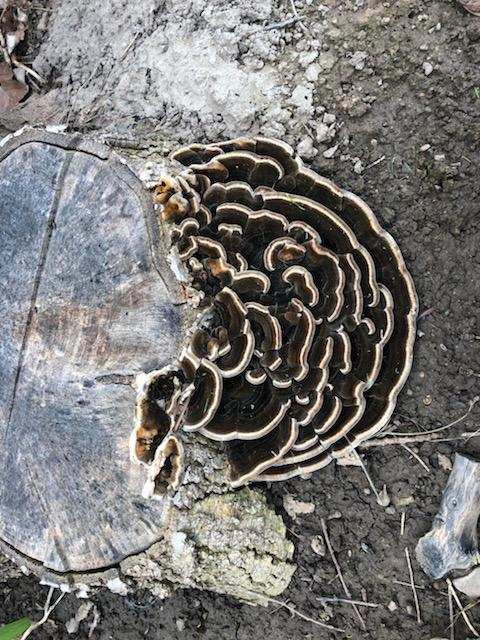Garden Help Desk: Are conks poisonous?
- If the fungal growths on trunks and stumps are soft, they can be removed, but the fungal activity inside the trunk will continue.
- Conks, bracket fungi and other mushrooms that grow on tree trunks are an outward sign of fungal activity inside a tree or stump. They are part of the natural decomposition process.

Courtesy photo
If the fungal growths on trunks and stumps are soft, they can be removed, but the fungal activity inside the trunk will continue.
What kind of mushrooms are these? Are they poisonous? Are there special instructions on their removal? What do you recommend?
These beautiful structures are the fruiting bodies of fungi that work as decomposers of dead organic matter, such as these stumps in your mother’s yard. They’re often referred to as conks, bracket fungi or shelf fungi. I’m afraid I can’t tell you whether these are poisonous — many conks are, some aren’t, but it requires expertise to know the difference.
Some fungal structures like these can be easily removed, especially if they’re soft, but most are woody and nearly rock-hard. Removing them won’t stop the activity of the fungal organisms inside the stump. Because they are so tough, the best method for removing these, if you’re worried about having them around, is to remove the rest of the stump. Or you can just enjoy another example of nature at work in your landscape, and use the stump as a stand for one of your container gardens next summer.
Can you please help me identify the type of grass I have? I need to know what kind of grass I have so that I can over-seed it to bring to life some patchy and dead areas after this hot summer. I think it might be Kentucky bluegrass.
To do an accurate ID you would need to provide a sample of several grass plants that includes roots as well as blades (preferably with some un-mown blade tips) that could be examined with a microscope or hand lens to look for specific characteristics.

Courtesy photo
Conks, bracket fungi and other mushrooms that grow on tree trunks are an outward sign of fungal activity inside a tree or stump. They are part of the natural decomposition process.
We could certainly take a look at a sample, but I’m not sure how useful it would be to know what kind of grass you have. Most lawns in our area are either Kentucky bluegrass lawns or lawns with a blend of Kentucky bluegrass and turf-type fescue or perennial ryegrass. A similar blend would fit in with nearly all Utah County lawns.
You mentioned patchy and dead areas in your lawn. There are a few fungal diseases that have become more common here in the past several years. These diseases cause dead areas in lawns and Kentucky bluegrass is susceptible to all of them. Turf-type tall fescue and perennial rye grass are both either very resistant or immune to some of the diseases, so over-seeding with a mix that includes one of those species could give you a healthier lawn, not just a lawn that looks good again.
I planted some Limelight hydrangeas in my flower beds this spring and am not sure the best way to overwinter them. Should I ever water them, and how often if so? Do they need any special covering or mulching? I believe they shouldn’t be deadheaded/pruned until after the last frost next spring — is that correct? Is there anything else I should do?
The weather is cooling off and the days are getting shorter — the two important signals your hydrangeas need to begin shifting into dormancy. They should do just fine this winter.
Your hydrangeas needed a deep soak about once every 6-7 days during the summer. They still need watering now, just much less often. Water them deeply about once every 10-14 days or until the sol has dried slightly but delay your watering if your garden gets any autumn rain. Limelights don’t tolerate wet soils, so the less frequent watering is important. And a 2- to 3-inch layer of small or medium bark nuggets in your shrub beds before winter is always a good idea.
One of the perks of growing these hydrangeas in your shrub and flower beds is that they also make nice cut flower. If you leave the flowers on the plants to dry, instead of deadheading, you’ll also have some pretty dried flowers to enjoy in the winter. You don’t need to worry about deadheading any time because deadheading isn’t the same as pruning; you’ll be cutting your plants back halfway instead of just removing spent flowers. Limelight hydrangeas bloom on new stems, so you’ll definitely need to do that pruning, but do it in late winter or early spring instead of waiting for the last frost.





